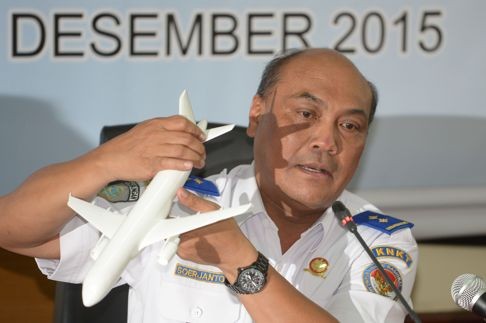Indonesian AirAsia QZ8501 crash in 2014 which killed 162 due to ‘faulty solder’
Flight system computer malfunctioned repeatedly, including four times during fatal journey
PUBLISHED : Tuesday, 01 December, 2015, 3:59pm
UPDATED : Tuesday, 01 December, 2015, 6:13pm
AFP, Reuters in Jakarta

Rescuers and divers with the tail of AirAsia QZ8501 plane on the deck of the Indonesian Rescue ship Crest Onyx after lifted from the sea floor off Pangkalan Bun, Central Borneo, Indonesia in January 2015. Photo: EPA
Indonesian investigators said on Tuesday a chronically faulty component and the crew’s attempt to fix the problem were among the factors that contributed to the crash of an AirAsia passenger jet last year, killing all 162 aboard.
A consistently malfunctioning rudder control system has been blamed for the crash in a final report from Indonesia’s National Transportation Safety Committee, the official investigators into the cause of the crash.
Cracked solder joint
The plane’s flight control computer had a cracked solder joint that malfunctioned repeatedly, including four times during the flight, sending shrieking warnings through the cockpit.
When they received the fourth warning, the pilots tried to reset a computer system by pulling out circuit breakers in a desperate attempt to fix the flight control system problem.
But the move also turned off the plane’s autopilot, sending it into a sharp roll from which they were unable to recover.
“Subsequent flight crew action resulted in inability to control the aircraft ... causing the aircraft to depart from the normal flight envelope and enter a prolonged stall condition that was beyond the capability of the flight crew to recover,” the national transport safety committee said in a statement.
The report said the faulty component, the Rudder Travel Limiter, had suffered 23 problems in the past 12 months, citing maintenance records.
Weather not at fault
Weather which hampered attempts to find the plane and recover the bodies of passengers was in the end not a factor in the crash, according to investigator analysis of flight data recorders. 56 bodies were never recovered from the choppy Java Sea.
The Airbus A320 aircraft crashed less than halfway into a two-hour flight from the Indonesian city of Surabaya to Singapore on December 28 last year.

Soejanto Tjahjono, Indonesian head of the National Transportation Safety Committee demonstrates on a model plane as he explains how AirAsia’s A320 crashed. Photo: AFP
The main body of the plane was eventually located on the seabed by a Singapore navy ship and both black box data recorders were recovered.
Search efforts were finally called off in March after almost three months of hunting.
An Indonesian minister previously described how the plane climbed fast and then went into aerodynamic stall, losing lift, before it went down, while an investigator said the warning alarms were “screaming” as the pilots desperately tried to stabilise the aircraft.
Co-pilot at controls
Investigators had also revealed that the French co-pilot, Remi Plesel, was at the controls of the AirAsia plane in the moments before it crashed, rather than the more experienced pilot, Captain Iriyanto, who had around 20,000 hours of flying time.
The crash was one of several aviation disasters in the sprawling archipelago in the past year, and the first major setback for Malaysia-based AirAsia group and its flamboyant boss Tony Fernandes after a spectacular run of success.
Indonesia’s air safety record
In August, a turbo-prop plane operated by Indonesian domestic carrier Trigana crashed in the remote, eastern region of Papua during a short flight in bad weather, killing all 54 people on board.
And in June an Indonesian military plane went down into a residential neighbourhood in the city of Medan, exploding in a fireball and killing 142 people.
Indonesian airlines are expanding rapidly after years of strong economic growth and the emergence of a new middle class, who have the money to fly around the more than 17,000 islands that make up the archipelago, rather than travel by road or sea.
But existing infrastructure is inadequate and carriers are struggling to find enough well-trained personnel to keep up with the boom, experts say.
